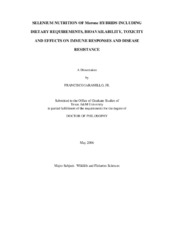| dc.description.abstract | Aquacultural production of hybrid striped bass (HSB) Morone chrysops × M.
saxatilis is highly vulnerable to losses from bacterial pathogens such as Streptococcus
iniae. Therefore, research was conducted to evaluate various dietary factors that may
enhance immunocompetence and disease resistance of HSB. In the first experiment,
purified and practical diets were supplemented with β-glucan and selenium in a factorial
arrangement and fed to juvenile HSB for 6 wk followed by a S. iniae challenge. Weight
gain (WG) and feed efficiency (FE) were higher for fish fed either practical diets or
purified diets supplemented with selenium, but not those supplemented with β-glucan.
Survival after disease challenge for fish fed the selenium-supplemented practical and
purified diets was 75% and 35%, respectively.
Because selenium supplementation also improved WG and FE, and because
selenium and vitamin E have complementary biochemical functions, a second
experiment evaluated potential interactions by feeding purified diets with or without
vitamin E or sodium selenite (Na2SeO3), singularly or in combination, for 12 wk.
Dietary selenium significantly affected whole-body selenium concentration but there was no effect of dietary selenium, vitamin E or their interaction on WG, FE, survival or
blood neutrophil oxidative radical production.
Three additional 12-wk experiments were conducted to establish selenium
essentiality, toxicity, tissue deposition, dietary requirements, bioavailability and nonspecific
immune responses using purified diets with a basal selenium level of 0.11
mg/kg. In one experiment, diets had selenium concentrations of 1.19, 2.00, 5.17 and
21.23 mg/kg from Na2SeO3. Another experiment had selenium concentrations of 0.90,
1.26 and 2.55 mg/kg from seleno-DL-methionine. The third trial utilized selenium from
Na2SeO3, seleno-DL-methionine and selenium yeast at approximately 0.15, 0.30 and
0.60 mg/kg diet.
No overt selenium deficiency signs were observed in any of the three latter
experiments, but based on selenium retention values, a minimum dietary requirement of
approximately 0.1 mg/kg was estimated. Selenium toxicity was observed in fish fed the
diet containing more than 20 mg/kg. Bioavailability of selenium sources was ranked as
seleno-DL-methionine > selenium yeast > Na2SeO3. | en |


